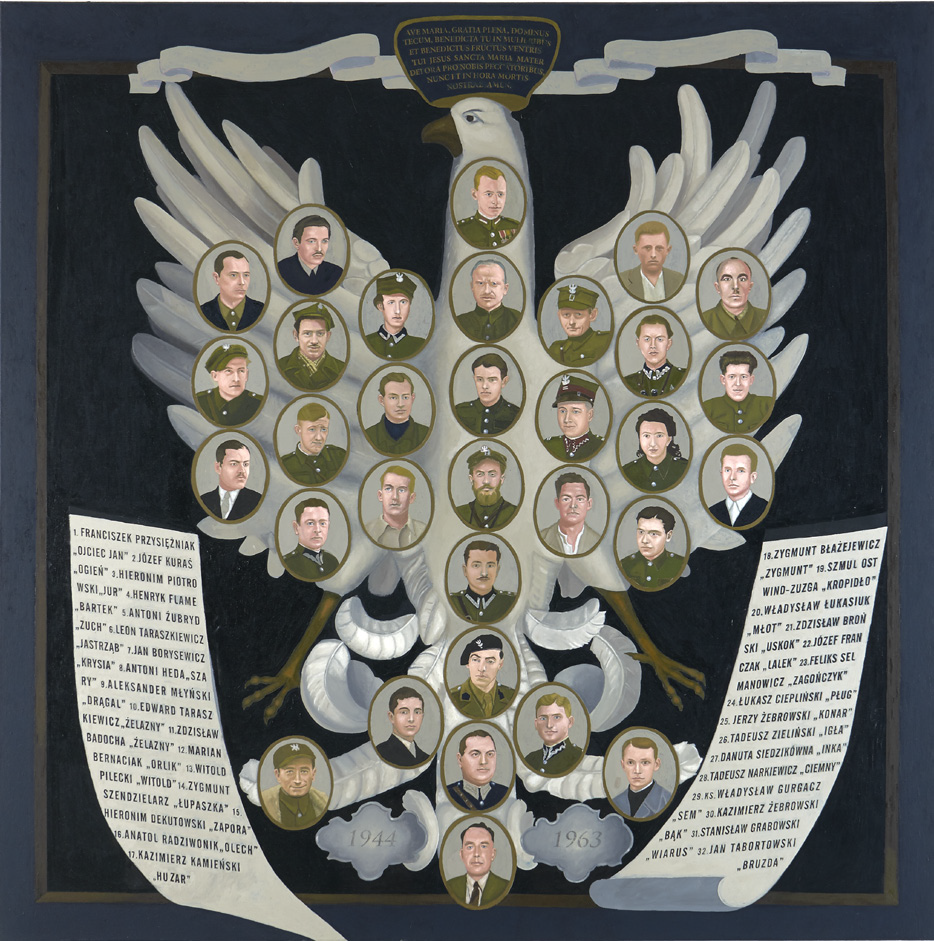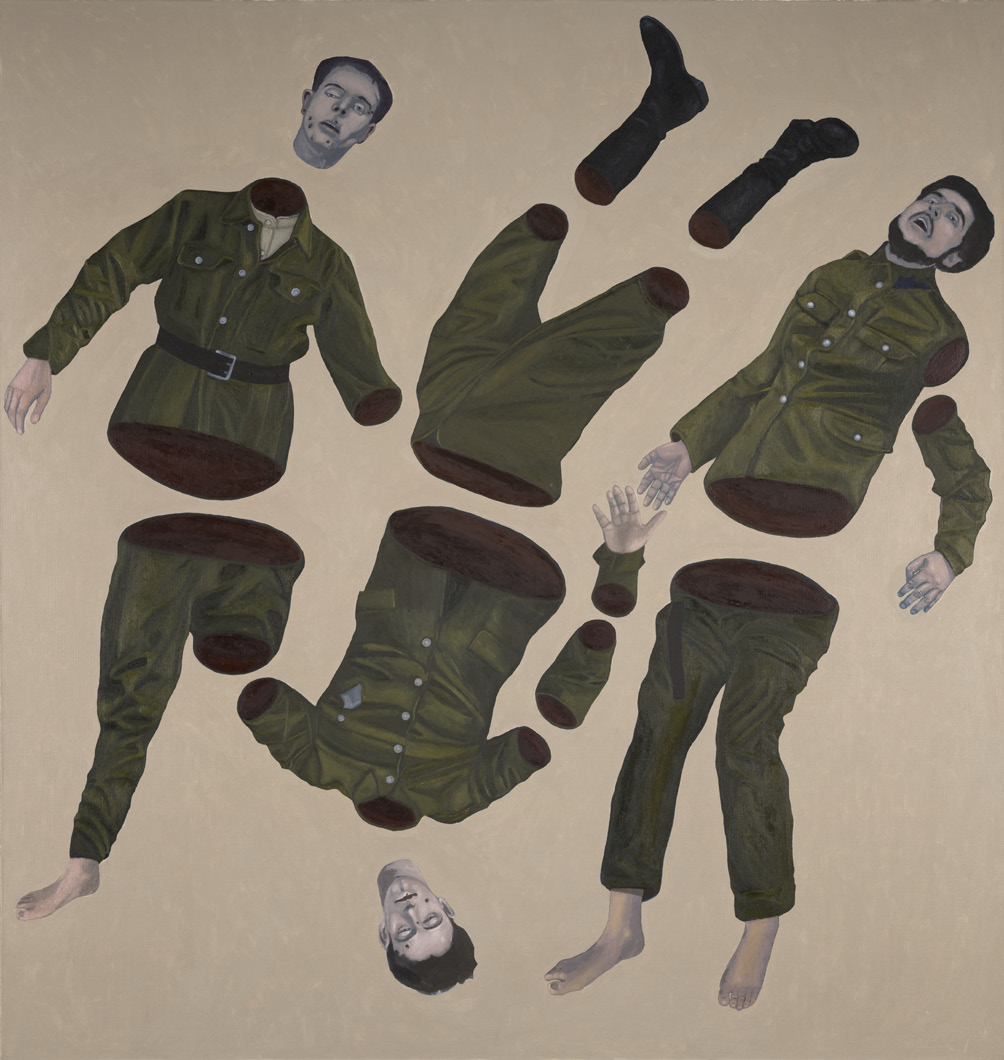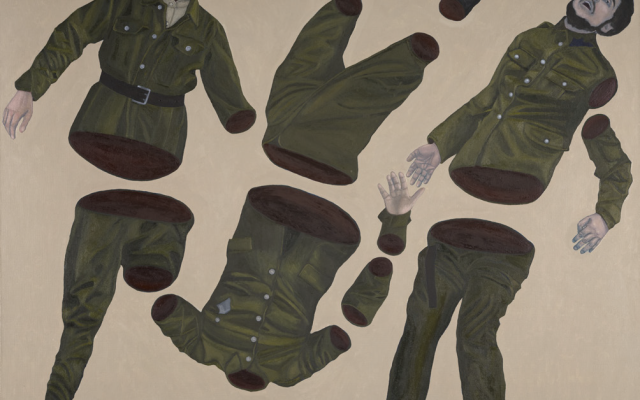The 'Cursed Soldiers', often referred to as 'The Indomitable’, remain heroes of the struggle for independence for a large part of Polish society. However, a notorious legend is constantly being developed that portrays them as gangs of degenerates and cruel men. This resentment was built up from the top down. It started with the infamous poster that juxtaposed a giant with a dwarf covered in spit. From there it went on...
Although the People's Republic of Poland partially rehumanised the Home Army (AK), the "gangs hiding in the woods" remained an essential motif for portraying the heroism of the boys of the stalinist Internal Security Corps (KBW). This campaign to demonise the anti-communist resistance in Poland involved popular culture on a massive scale. It was evident in films depicting the struggle to build socialism in Poland. Firemaster Kaleń fought not only the Ukrainian Insurgent Army (UPA) but also the "Foresters", while Bruno Oya in the western "Wolf's Echoes" had to deal with the primitive "London chumps". There was the series "With Tiger", eagerly read by young people after the war, which often depicted fights with the gangs. In it, Łupaszka was portrayed as a "rufous bandit" who murdered with a sadistic smile. From these little tomes we learned about the crimes of 'Żubryd', 'Ogień' and 'Piorun'. And there was no room for nuance.
In the 1970s, when Poland opened up to Western influences, comics were included in the condemnation of "bandits". The new regime was fighting the UPA Sotnias, former SS men from the Wehrwolf and the 'Foresters'. They all had ugly features, drank vodka and were surrounded by vulgar-looking women. And so every recipient of the popular culture of the People's Republic of Poland was slowly imbued with the conviction that it was better that these spiteful, ugly dwarfs had lost, because the world would have been much uglier if they had won. Even aesthetically...
After 1989, much began to change, including culturally. This has softened the edge of the critique of the Indomitable, though one can hardly speak of a major shift. There was no mass production of poetry and novels dedicated to the people banned by the Soviet regime from the pantheon of national heroes. The most common reference was to Herbert's poem 'Wolves', and the 'wolf trail' became one of the few, and like the poem itself, an ephemeral and transient sign of remembering the Home Army.
A few comics and films were released, but they did not make much impression on Polish audiences. The television theatre has made up for that by offering some interesting plays. The majority, however, were more in the vein of volume than emotion, whether positive or negative. The "Cursed" did not become heroes of high art, although their holiday was established. Instead, they remained on the fringes of politics, social activism and the popularisation of history. All the more so because our knowledge of history has led us to see them as at least ambiguous figures. Time and again, there were also reports of deeds which were hardly worthy of praise. As a result, a large part of the Polish population remained indifferent to the history of the partisans in the post-war period or continued to show aversion towards them.
Although we know a great deal about them, this knowledge has hardly inspired any significant works. Instead of paintings, we have murals; instead of novels, we have popular-scientific divagations by publicists. Instead of sculptures, we have monuments, which we Poles love but are not always capable of creating.
That is why, when the gallery-sized paintings depicting the pro-independence partisans appeared on the fringes of the art world, the silence began. A few comments were made about the publicity they received, and it was often thought that this would be enough, that the issue would pass, that it wouldn't be noticed, that it would be muted. However, it was not a lowly painter specialising in murals and fairground wedding portraits, but a leading artist who decided to take up the cause.
Ignacy Czwartos developed his style through a laborious process, starting with the Polish masters of modern art - Nowosielski, Wróblewski or Fijałkowski. At the same time, he followed the trend of abstract painting, represented by the greatest painters of our time, like Rothko and Malevich. Abstract painting remains close to his heart, but he no longer creates large compositions. Instead, he uses them - as a fragment of a painting - to show a reference to that metaphysical reality for which many viewers of his paintings yearn and into which non-figurative painting can perfectly lead.
It is no wonder, therefore, that he also made his masters, Malevich, Rothko, Nowosielski, Strzemiński, Wróblewski, the protagonists of his great canvases, sacralising the figures they represent... These paintings combine the iconographic motif of the Sacra Conversatione, in which saints suspended out of time discuss the most important things, with contemporary portraiture, which does not overemphasise the surroundings and the richness of the clothes, but seeks to show the essence of the person portrayed. This medieval motif is rediscovered in the art of the Baroque period, which is so important for the artist and his painting.
The artist does not hide the fact that he is fascinated by the Polish art tradition of the time, calling himself "modern Sarmatian". It is difficult to capture in a few words the multitude of associations and references that these words and their images evoke in the reader. The culture of the nobility, created by people who called themselves the descendants of the ancient nomads of the Eastern European steppes, developed in the 16th and 17th centuries, left its mark on the Polish culture of later times and continues to influence it to this day. The visual associations are obvious: the coffin portrait, which is a peculiar hallmark of modern Polish painting, figures of the nobility or, finally, pious, devotional paintings, evoke clear visual associations in the viewer.
The dense space of the canvases, the blank ground, the simplified forms of the human characters allude to the Sarmatian culture of the seventeenth and eighteenth century. Thus, the football fans, nuns and independence underground soldiers in Czwartos' paintings are direct descendants of our noblemen, nuns or noble burghers who lived in the Polish-Lithuanian Commonwealth. The painter does more than simply convey certain meanings and ideas in his bold references to images of saints or coffin portraits. Other means of expression could have done this. In the artistically remarkable epitaphs of the great painters, his masters, he has done the same thing. These are not saints, but Czwartos, by means of a purely formal reference to religious paintings, gives his figures a 'superhuman', heroic character.
He clearly found himself in this Baroque world, not as a Sarmatian to distinguish himself from his contemporaries, that for him the culture of old Poland was not something past. He has no need to break with the great tradition, because this does not separate his painting in the least from that of his contemporaries.
Critics responded favourably to Czwartos' work in its 'baroque' manifestation. His posthumous paintings of great painters, and even his direct references to Baroque art, did not raise any objections. His use of condensed space and muted colours also found favour with the critics. But the more famous he became, the more controversial his work became. He was criticised for painting what he, and many of his contemporaries, saw as 'rehabilitating' German crimes. Hence, they remind and warn that evil is not dead and can always be reborn. But most controversial of all are his representations of the 'Indomitable Soldiers'.
Let us try to embrace this latter group of images without prejudice or preconception. They are worthy of direct insight and reflection. They alone will best explain to the viewer - should he choose to look at them without prejudice - the reality they depict. This does not in any way imply that everyone who leaves the exhibition will be in agreement with the ideas of the paintings and of their creator.

Ignacy Czwartos, Treter’s Eagle (pl. Orzeł Tretera), 200x200 cm, oil on canvas,
2017. Property of Center for Contemporary Art Ujazdowski Castle.
“The Eagle” painting is an explicit reference to a 17th-century engraving by Tomasz Tretter depicting the Polish monarch Sigismund Vasa as the heir to previous rulers. The medallions arranged on the bird's body - the coat of arms of the Kingdom of Poland - show busts of rulers from Leszek I to Sigismund III. Combining the Royal Coat of Arms with the family tree, it shows the tradition to which the Swedish-born King of Poland wished to be linked. But Czwartos's image goes much further. Although it is undoubtedly a repetition of a Baroque form and concept (the medallions with the "Cursed" are preserved in a neo-Baroque manner, characteristic of the painter), the idea is more in keeping with the Romantic tradition, where the rulers of the national spirit were poets and warriors who shed their blood "for our freedom and yours". Pilecki, 'Ogień', 'Szary', 'Inka' and many others did not so much replace Sigismund and Boleslaw on the Polish throne, but rather Kościuszko, Langiewicz or Emilia Plater. But Tretter's Eagle, in the artist's own words, places his underground heroes in another stream. In the stream of chivalric tradition, which refers not only to Grunwald, but also to the Second Republic of Poland, where Sienkiewicz's heroes were knights, heirs not only to military superiority, but also to honour and a sacred love for the homeland. It is no coincidence that 'Kmicic', 'Bohun', 'Rzędzian' and 'Skrzetuski' [names of heroes from Sienkiewicz's novels] abounded in the Polish underground during the German and Soviet occupations. This heredity was described by the artist himself:
In fact, it's a reference to the continuity of aristocratic, chivalrous attitudes, which, although no longer based on ancestry - most underground soldiers after 1944 came from the peasantry and petty nobility - continue to uphold the values of the community. The Tretter eagle has always appealed to me, but the kings depicted on it seem distant to us today. The underground heroes, on the other hand, were there, but largely forgotten. I thought it was worth honouring them in this way, putting them on the same level as the kings. In a way, I was also referring to my own childhood, playing with plastic soldiers, which certainly influenced my way of thinking and painting.[i]
This is certainly the place to reflect on the claim that Ignacy Czwartos' painting is ‘publicistic’ and ‘simplistic’ (I will leave out the epithets). His "Eagle" is a multi-layered allegory, the invention and translation of which into a pictorial language required not only careful thought, but also erudition and knowledge of the nation's history to an extent that goes beyond the usual.
A curious example of erudition is the painting “Fish”, in which the bodies of slain partisans are dismembered and arranged side by side, imitating Andrzej Wróblewski's famous painting of the same name. The dehumanisation of the victims of war and terror makes their sacrifice all the more terrible and heartless. It is noteworthy that Czwartos is not the only one with references to Wróblewski's work; there are also references in contemporary art by painters whose aim is to depict the horrors of war, such as the one currently taking place in Ukraine.
Both "The Fish" and the "Epitaph for Józef Franczak 'Lalek'", which depicts the murdered heroes of the Independence Underground, refer to the painting of the old Poland in its baroque character, but they also fit into the universe of Wróblewski's imagination. There is more here than just a reference to the way in which the works are composed or to the expressive arrangement of the bodies. The painter also refers to the complex colour symbolism used by his predecessor (although he creates his own, sometimes even subversive one), and to the way in which he approaches the problem of the transitus, i.e. passing from the temporal to the 'other side'.
Other 'partisan' paintings, in this mixed 'baroque-modern' manner, either show the bodies of murdered soldiers truly shocking in their realism or, on the contrary, depict them already 'on the other side', out of time, as in epitaphs or paintings depicting the communion of saints. This 'commemoration' - a non-religious sacralisation - of the heroes of these paintings serves a very important purpose and carries a very significant meaning.
The painter has an excellent knowledge of the contemporary history of Poland, so he knows very well that the figures he is painting are not absolutely ideal. He knows that their portraits have scratches, sometimes very serious ones, because they had their weaknesses and serious faults. And even in human, everyday terms, it would be difficult to see them as charming gentlemen from court parlours or as knights who prevailed in jousting.
For what did he find in them that made him begin to give them a bronzed, monumental character with his simple but refined painterly manner? That he smoothed and sanded the scratches, glued the cracks and polished the bronze of the monument? And what is it about these paintings that makes them so attractive to spectators in other countries and on other continents? In fact, we are already seeing more than just the freedom fighters of a particular country. They are, in a way, participants in the great procession of those who, in the face of an ‘ultimate situation’, have given the right answer.

Ignacy Czwartos, Fish 2 (pl. Ryby 2), 200x190 cm,
oil on canvas, 2023.
This term, which may not have been coined by Jaspers, but which was certainly popularised by him, is broad enough to be used in communication between people of different cultures, different points of view or even different religions. Confronting a factor that has an overwhelming influence on us, and against which we can do nothing, not only reveals the truth about ourselves, but also has the power to shape who we can become. Ultimate situations, especially death, cannot be denied; indeed, we keep trying to deny them, but this is the most common self-deception in the world.
[…] because its source is in ultimate situations, expresses the basic drive to find a revelation of true being in human failure. Crucial for man is his attitude toward failure: whether it remains hidden from him and overwhelms him only objectively at the end or whether he perceives it unobscured as the constant limit of his existence; whether he snatches at fantastic solutions and consolations or faces it honestly, in silence before the unfathomable. The way in which man approaches his failure determines what he will become. In ultimate situations man either perceives nothingness or senses true being in spite of and above all ephemeral worldly existence. Even despair, by the very fact it is possible in the world, points beyond the world.[ii]
There can be no doubt that the attitude of ‘indomitability’ associated with anti-communist resistance by those praising it is a response to an ultimate situation. But isn't making the greatest sacrifice sometimes the best possible way to respond? Even if one had no control over it. No soldier goes into battle to die, but to fight and win, even if it means dying. Czwartos claims that it is precisely because of the right attitude in a Jasperian final situation that the victims in his paintings are victorious.
This belief is universal to the human species. Anyone who doubts this should recall another image of a dead man that became world-famous, taking the form of a 'pop-cultural' political icon. This is, of course, the image of Che Guevara that became one of the most famous visual political manifestos of the world.
Czwartos would never have thought of glorifying communist revolutionaries, but he does so with the partisans who fought for their country's freedom, often without fully understanding the meaning of the slogan. In many cases they were not crystal-clear figures, but in the face of the ultimate situation, their choice of indomitability was an existential answer. And this is exactly what Ignatius Czwartos portrays in his great canvases.
[i] Culture tamed with death. Interview with Ignacy Czwartos (pl. Kultura oswojona ze śmiercią. Rozmowa z Ignacym Czwartosem), article published on www.teologiapolityczna.pl on 21.08.2023, (accessed 18.02.2024).
[ii] Karl Jaspers, Way to Wisdom. An Introduction to Philosophy, transl. R. Manheim, Yale University Press, 1954, p. 23.


